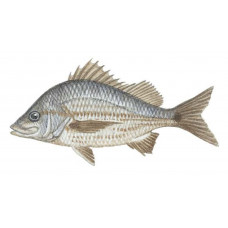Latin name
Haemulon aurolineatum
Other names
Tomtate grunt; Spanish: ronco jeníguano.
Identification
Tomtate has a slender body, silver-white coloration, and a yellow-brown stripe along the entire length of the body, ending with a dark spot on the caudal fin. The pelvic and anal fins are yellowish. The inside of the mouth is red. It has 13 dorsal spines and 14-15 dorsal rays, 9 anal rays and 17-18 pectoral rays.
Distribution
Tomtate inhabits the Western Atlantic from Massachusetts and Bermuda to Brazil, including the Caribbean and the Gulf of Mexico.
Habitat
Tomtate prefers shallow water, from nearshore to outer reefs, as well as rocky and sandy bottoms. Often you can see clusters of individuals near jetties or docks.
Size
Maximum length is 10 inches, but rarely exceeds 8 inches. Tomtates live up to 9 years.
Life history and Behavior
Like other grunts, this species is a schooling fish, often found in large groups near natural and artificial reefs. Sexually mature individuals reach a size of 51⁄2 inch, and spawning occurs in the spring in the southeastern United States.
Food and feeding habits
Tomtate is a bottom feeder, feeding on worms, snails, shrimps, crabs, and amphipods. These, in turn, are food for various Lucians, grouper and mackerel.
Reproduction
No information
| Classification | |
| Phylum | Chordata |
| Class | Actinopterygii |
| Squad | Perciformes |
| Family | Haemulidae |
| Genus | Haemulon |
| Features | |
| Conservation status | No information |
| Habitat | Pelagic |
| Life span, years | No information |
| Maximum body weight, kg | No information |
| Maximum length, cm | No information |
| Sailing speed, m/s | No information |
| Threat to people | No information |
| Way of eating | Predator |
Tomtate
Tags: Tomtate


